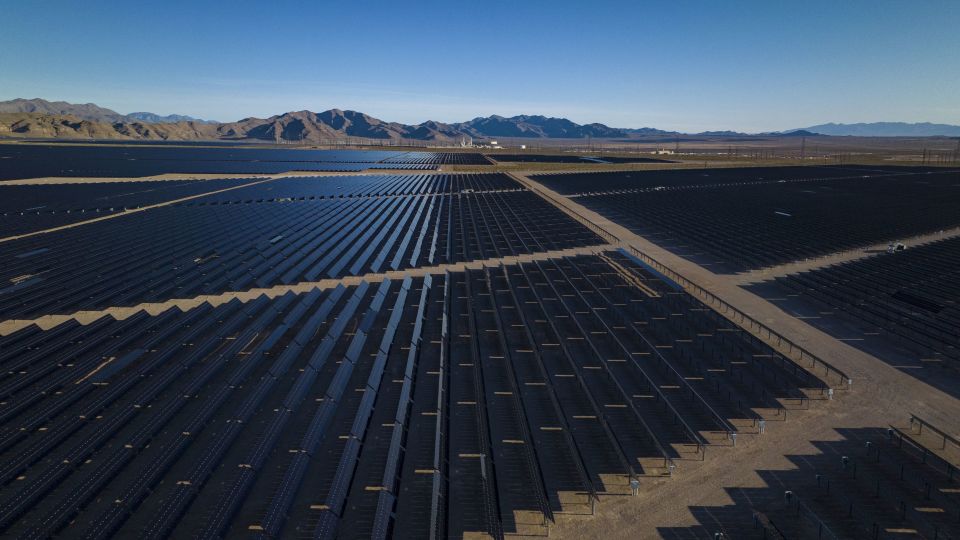The Trump administration’s cancellation of the largest solar project in the United States has sparked confusion and concern among Republicans and Democrats alike.
Known as the Esmerelda 7, the collection of seven solar projects in rural Nevada was set to generate up to 6.2 gigawatts of energy when complete, enough to power 2 million homes. That’s an eye-popping amount of power to add to an electrical grid that desperately needs more of it, due to the insatiable demand from AI-related data centers and increasing residential needs.
Under former President Joe Biden, the federal government was moving the sprawling project through the federal permitting process as one proposal. Developers had planned to use 118,000 acres of federal land in Nevada’s desert as the home for solar arrays and batteries to store the sun’s energy.
Last week, the Interior Department’s Bureau of Land Management quietly changed the project’s status to “canceled” on its federal permitting webpage. An Interior Department spokesperson said the status change was unrelated to the ongoing government shutdown and that project developers and the federal government had agreed to “change their approach” as part of “routine discussions” about the project.
There may still be a path forward for the Esmerelda 7; the Interior spokesperson said developers “will now have the option to submit individual project proposals to the BLM” for approval. However, environmental impact analyses can drag on for months or years, making the approval process much longer. And the federal government can also cancel individual projects again.
The project’s cancellation was first reported by Heatmap News.
Although the project was greenlit by the Biden administration, it remained controversial with some conservation groups and residents, who feared the sheer size of the solar arrays would impact critical desert wildlife habitat.
Desert tortoises and Joshua trees live in the area that would be developed for the solar array, said Erik Molvar, executive director of the Western Watersheds Project.
“It doesn’t make sense to trade off gains in climate while sacrificing biodiversity,” Molvar said. “We don’t see the conversion of vast areas of public land to renewable energy as the right solution to the climate crisis.”
NextEra Energy, one of the developers involved, said they “remain committed” to pursuing the project “and will continue to engage constructively” with the Bureau of Land Management, according to company spokesperson Neil Nissan.
The move to pull the plug on the project’s permitting approvals drew rare criticism from politicians of both parties.
“This is how we lose the AI/energy arms race with China,” Utah’s Republican Gov. Spencer Cox posted on X. “Solar with batteries can now be close to baseload power and we should keep these projects rolling until we get the gas/nuclear/geothermal plants we need.”
Nevada’s two Democratic senators blasted the move and urged Interior Sec. Doug Burgum to clarify the project’s future.
“The Trump Administration’s lack of transparency around wind and solar projects has caused chaos and confusion,” Sen. Catherine Cortez Masto said in a statement, adding solar has been a major economic driver in her sunny state.
“Nevada is a national leader in solar energy as the state with the most solar jobs per capita, and the Trump Administration’s attack on this industry will have dire effects on our economy,” added Sen. Jacky Rosen in a statement.
While the Trump administration has largely targeted wind projects via a series of stop work orders and cancellations, it has also created additional hurdles for solar projects to get through federal review. Earlier this year, Trump and congressional Republicans effectively killed tax credits for wind and solar projects, dramatically shortening the timeline during which developers could claim the credits.
An independent analysis from think tank Energy Innovation released this summer showed killing the tax credits would further raise US household energy bills over the next decade.
Since 2022, retail electricity prices have increased faster than the rate of inflation, according to the US Energy Information Administration, which predicts prices will continue to rise through next year. Electricity prices are Americans’ second biggest annual energy expense, after paying for gasoline to fuel their vehicles, the EIA found.
President Donald Trump has made his distaste for wind and solar known in speeches and posts on social media, as well.
“We will not approve wind or farmer destroying Solar,” Trump posted on Truth Social in August, calling renewables “the scam of the century.”
For more CNN news and newsletters create an account at CNN.com

